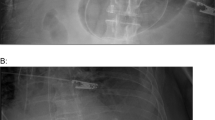Abstract
Objective:
Given the distressingly high incidence of ETT malposition in the neonatal population, patients are exposed to ionizing radiation to confirm endotracheal tube (ETT) position. Our objective is to determine if ultrasound technique is concordant with X-ray in determining whether an ETT is deeply positioned or not.
STUDY DESIGN:
Prospective observational clinical trial. After obtaining informed consent, patients with an ETT who required X-ray for clinical reasons underwent sonographic evaluation of the ETT by an ultrasound technologist or pediatric radiologist, usually within the hour.
Results:
A total of 56 image pairs were obtained from 29 patients. Ninety-eight percent of the ultrasound/X-ray image pairs were suitable for analysis. The concordance of ultrasound with X-ray to identify deeply and not deeply positioned ETTs was 95% (53/56). The sensitivity of ultrasound to detect deeply positioned ETTs on X-ray was 86% (6/7). The specificity of ultrasound to detect ETTs that were not deeply positioned on X-ray was 96% (47/49).
Conclusions:
As the largest clinical trial of its kind to date, with the greatest number of ultrasound operators, we have further established US as a feasible imaging modality to determine whether an ETT is deeply positioned or not.
This is a preview of subscription content, access via your institution
Access options
Subscribe to this journal
Receive 12 print issues and online access
$259.00 per year
only $21.58 per issue
Buy this article
- Purchase on Springer Link
- Instant access to full article PDF
Prices may be subject to local taxes which are calculated during checkout


Similar content being viewed by others
References
Harris EA, Arheart KL, Penning DH . Endotracheal tube malposition within the pediatric population: a common event despite clinical evidence of correct placement. Can J Anaesth 2008; 55 (10): 685–690.
Schmolzer GM, O'Reilly M, Davis PG, Cheung PY, Roehr CC . Confirmation of correct tracheal tube placement in newborn infants. Resuscitation 2013; 84 (6): 731–737.
Lingle PA . Sonographic verification of endotracheal tube position in neonates: a modified technique. J Clin Ultrasound 1988; 16 (8): 605–609.
Alzen G, Benz-Bohm G . Radiation protection in pediatric radiology. Dtsch Arztebl Int 2011; 108 (24): 407–414.
Slovis TL, Poland RL . Endotracheal tubes in neonates: sonographic positioning. Radiology 1986; 160 (1): 262–263.
Dennington D, Vali P, Finer NN, Kim JH . Ultrasound confirmation of endotracheal tube position in neonates. Neonatology 2012; 102 (3): 185–189.
Blayney MP, Logan DR . First thoracic vertebral body as reference for endotracheal tube placement. Arch Dis Child Fetal Neonatal Ed 1994; 71 (1): F32–F35.
Scott MV, Fujii AM, Behrman RH, Dillon JE . Diagnostic ionizing radiation exposure in premature patients. J Perinatol 2014; 34 (5): 392–395.
Harvey EB, Boice JD Jr, Honeyman M, Flannery JT . Prenatal x-ray exposure and childhood cancer in twins. N Engl J Med 1985; 312 (9): 541–545.
Pearce MS, Salotti JA, Little MP, McHugh K, Lee C, Kim KP et al. Radiation exposure from CT scans in childhood and subsequent risk of leukaemia and brain tumours: a retrospective cohort study. Lancet 2012; 380 (9840): 499–505.
Brenner DJ, Hall EJ . Computed tomography–an increasing source of radiation exposure. N Engl J Med 2007; 357 (22): 2277–2284.
Arad I, Simanovsky N, Braunstein R . Exposure of extremely low birth weight infants to diagnostic X-Rays: a longitudinal study. Acta Paediatrica 2009; 98 (2): 266–269.
Vachharajani A, Vachharajani NA, Najaf T . Neonatal radiation exposure. Neo Rev 2013; 14 (4): e190–e197.
Torloni MR, Vedmedovska N, Merialdi M, Betrán AP, Allen T, González R et al. Safety of ultrasonography in pregnancy: WHO systematic review of the literature and meta-analysis. Ultrasound Obstet Gynecol 2009; 33 (5): 599–608.
Fowlkes JB, Bioeffects M . Committee of the American Institute of Ultrasound in, American Institute of Ultrasound in Medicine consensus report on potential bioeffects of diagnostic ultrasound: executive summary. J Ultrasound Med 2008; 27 (4): 503–515.
Nyborg WL . History of the American Institute of Ultrasound in Medicine's efforts to keep ultrasound safe. J Ultrasound Med 2003; 22 (12): 1293–1300.
Mora-Matilla M, Alonso Quintela P . Is ultrasound a feasible tool to verify endotracheal tube position in neonates? Resuscitation 2013; 84 (1): e19–e20.
Vieira RL, Bachur R . Bedside ultrasound in pediatric practice. Pediatrics 2014; 133 (1): 1–3.
Acknowledgements
The primary author is a fellow in training and thanks Dr Barbara Dangman and Dr Joaquim Pinheiro for their unwavering commitment toward the development and completion of this clinical trial. Without their mentorship, this trial would not be possible. Additionally, the success of this trial was dependent on the participation of the staff of ultrasound technologists at The Children’s Hospital at Albany Medical center and they are due special recognition for their efforts.
Author information
Authors and Affiliations
Corresponding author
Ethics declarations
Competing interests
The authors declare no conflict of interest.
Rights and permissions
About this article
Cite this article
Chowdhry, R., Dangman, B. & Pinheiro, J. The concordance of ultrasound technique versus X-ray to confirm endotracheal tube position in neonates. J Perinatol 35, 481–484 (2015). https://doi.org/10.1038/jp.2014.240
Received:
Revised:
Accepted:
Published:
Issue Date:
DOI: https://doi.org/10.1038/jp.2014.240
This article is cited by
-
New Formula for Depth of Insertion of Endotracheal Tube in Children: A Prospective Observational Study
Indian Journal of Pediatrics (2024)
-
Three-Point Ultrasonography for Confirmation of Endotracheal Tube Position in Children (TRUCE Study)
Indian Journal of Pediatrics (2024)
-
Contemporary Use of Ultrasonography in Acute Care Pediatrics
Indian Journal of Pediatrics (2023)
-
Diagnostic accuracy of ultrasound for localising peripherally inserted central catheter tips in infants in the neonatal intensive care unit: a systematic review and meta-analysis
Pediatric Radiology (2022)
-
Point-of-Care Ultrasound-Guided Procedures in the Pediatric Cardiac Intensive Care Unit
Current Treatment Options in Pediatrics (2022)



